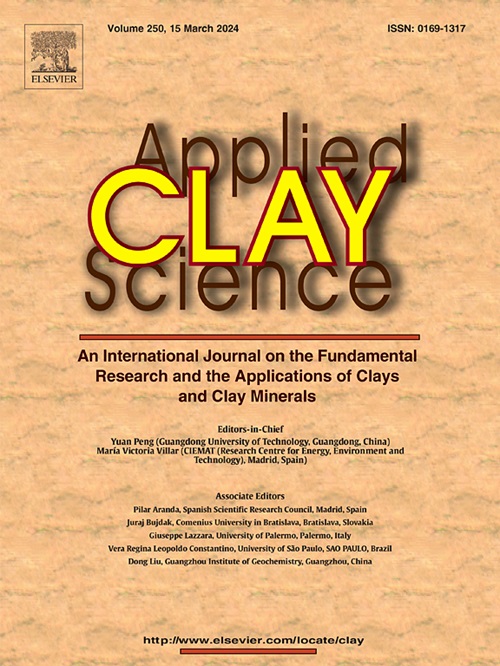Anti-disintegration property of red soil treated with building gypsum powder
IF 5.3
2区 地球科学
Q2 CHEMISTRY, PHYSICAL
引用次数: 0
Abstract
Red soil exhibits a tendency to soften and disintegrate upon exposure to water, posing significant geological hazards and engineering challenges. In the present study, building gypsum powder (BGP) was employed as a modifier to systematically investigate its influence on the resistance to disintegration of red soil under the influence of various alkaline admixtures. Utilizing a custom-built dry-wet cycle disintegration tester, in conjunction with microscopic analysis techniques including scanning electron microscopy (SEM), X-ray diffraction (XRD), XRF (X-ray Fluorescence) and mercury intrusion porosimetry (MIP), the enhancement mechanism of BGP on the microstructure of red soil was thoroughly investigated. The findings indicate that an increase in the dosage of BGP markedly enhances the resistance to disintegration of red soil, particularly when the dosage surpasses 5 %. Under the influence of various admixtures, BGP-modified red soil undergoes chemical processes, including ion exchange, crystallization, and volcanic ash reaction, leading to a significant reduction in porosity, an increase in density, and a marked improvement in the water stability of red soil. The dry-wet cycle test provided further confirmation that the admixture markedly improved the water stability of BGP-modified red soil. Furthermore, the quantitative relationship between the microstructural parameters of the modified red soil and its disintegration properties was established through the application of grey correlation analysis and fractal theory, elucidating the crucial role of pore perimeter and area in the resistance to disintegration of red soil. This research endeavors to establish a scientific foundation for the prevention and mitigation of debris flows, landslides, and other disasters in red soil regions, and to propose novel strategies for the selection of geotechnical enhancement materials.

建筑石膏粉处理红壤的抗崩解性能
红壤在接触水后呈现软化和崩解的趋势,构成重大的地质灾害和工程挑战。本研究以建筑石膏粉(BGP)为改性剂,系统研究了不同碱性外加剂对红壤抗崩解性能的影响。利用特制的干湿循环崩解仪,结合扫描电镜(SEM)、x射线衍射(XRD)、x射线荧光(XRF)和汞侵入孔隙度测定(MIP)等显微分析技术,深入研究了BGP对红壤微观结构的增强机理。结果表明,增加BGP的添加量可显著增强红壤的抗崩解能力,特别是当添加量超过5%时。在各种外加剂的作用下,bp改性红壤发生了离子交换、结晶、火山灰反应等化学过程,孔隙度明显降低,密度增加,红壤水稳定性明显改善。干湿循环试验进一步证实了掺入物明显改善了bp改性红壤的水稳定性。应用灰色关联分析和分形理论,建立了改性红土微观结构参数与其崩解性能之间的定量关系,阐明了孔隙周长和面积对红土抗崩解性能的重要作用。本研究旨在为红壤地区泥石流、滑坡等灾害的防治提供科学依据,并为红壤地区岩土加固材料的选择提出新的策略。
本文章由计算机程序翻译,如有差异,请以英文原文为准。
求助全文
约1分钟内获得全文
求助全文
来源期刊

Applied Clay Science
地学-矿物学
CiteScore
10.30
自引率
10.70%
发文量
289
审稿时长
39 days
期刊介绍:
Applied Clay Science aims to be an international journal attracting high quality scientific papers on clays and clay minerals, including research papers, reviews, and technical notes. The journal covers typical subjects of Fundamental and Applied Clay Science such as:
• Synthesis and purification
• Structural, crystallographic and mineralogical properties of clays and clay minerals
• Thermal properties of clays and clay minerals
• Physico-chemical properties including i) surface and interface properties; ii) thermodynamic properties; iii) mechanical properties
• Interaction with water, with polar and apolar molecules
• Colloidal properties and rheology
• Adsorption, Intercalation, Ionic exchange
• Genesis and deposits of clay minerals
• Geology and geochemistry of clays
• Modification of clays and clay minerals properties by thermal and physical treatments
• Modification by chemical treatments with organic and inorganic molecules(organoclays, pillared clays)
• Modification by biological microorganisms. etc...
 求助内容:
求助内容: 应助结果提醒方式:
应助结果提醒方式:


